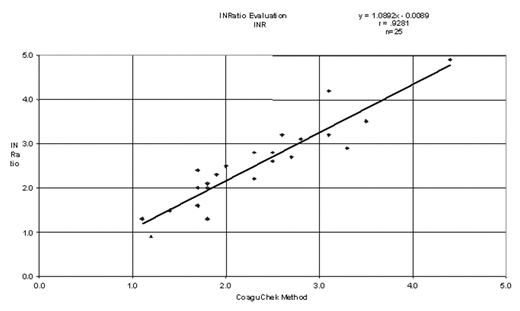Abstract
Point of care (POC) testing of International Normalized Ratio (INR) for monitoring warfarin therapy is rapidly becoming procedure of choice for patients requiring long term oral anticoagulation. This method allows for fingerstick blood sample to be used for INR testing at the point of service with immediate dose modification as needed. Most patients prefer a fingerstick method for blood draw to venipuncture. It is not known if venipuncture blood sample can be used for testing on POC machines. A significant number of patients in an oncology practice need additional laboratory testing on the same day as INR testing. These patients therefore get a fingerstick for POC INR testing and a venipuncture for other tests. We compared results of INR from venipuncture sample run on a POC machine (CoaguChek monitor) using CoaguChek test strips (ISI-2.0) with the INR performed on MDA analyzer (ISI-2.0). Blood samples from 24 patients on warfarin therapy were drawn from antecubital vein by a clean stick in a 10 cc plastic syringe. A drop of blood was immediately placed on the CoaguCheck test strip. Next the same blood sample was used to fill a 3.2% sodium citrate tube for testing on MDA analyzer. Results were analyzed using regression analysis; the correlation coefficient (r), slope and intercept were determined and following graph of the regression analysis was generated (see figure 1).
Conclusions: These results show a good correlation (r-value> 0.9) between the results of INR obtained on CoaguChek POC machine and the MDA analyzer using venipuncture blood sample. The preferred method to obtain blood sample for POC INR monitoring must remain fingerstick sample as per manufacturer’s recommendations. However, for those patients who need more than one blood sample done on the same day, a venipuncture sample as described above gives acceptable results when tested on CoaguCheck machine.
Author notes
Corresponding author


